Advertisements
Advertisements
Question
Draw ray diagrams for the cases of images obtained in concave mirrors as described in the table below.
| Images formed by concave mirrors | ||||
| No. | Position of the object | Position of the image | Nature of image | Size of the image |
| 1 | Between pole and focus | Behind the mirror | Erect, virtual | Magnified |
| 2 | At the focus | At infinity | Inverted, real | Very large |
| 3 | Between focus and centre of curvature | Beyond the centre of curvature | Inverted, real | Magnified |
| 4 | At the centre of curvature |
At the centre of curvature | Inverted, real | Same as the object |
| 5 | Object between infinity and Centre of curvature | Between the centre of curvature and focus | Inverted, real | Diminished |
| 6 | Object at infinity | At focus | Inverted, real | Diminished |
Solution
- Object between the focus (F) and the pole (P):

P: pole, C: Centre of curvature, F: Focus, PF: Focal length (f), PC: Radius of curvature (R), AB: Object, A'B': Image, PB: Object distance (u), PB': Image distance (ν)
Here, the image forms from behind the mirror. It is enlarged and virtually upright. - Object at the focus (F):

C: Centre of curvature, F: Focus, PF: Focal length (f), PC: Radius of curvature (R), AB: Object, PB: Object distance (u)
Here the image is formed at infinite distance. It is real, inverted and huge in size. - Object between the centre of curvature (C) and the focus (F):

C: Centre of curvature, F: Focus, PF: Focal length (f), PC: Radius of curvature (R), AB: Object, A'B': Image, PB: Object distance (u), PB': Image distance (ν)
Here the image exits the center of curvature. It is real, inverted and larger in size than the object. - Object at the centre of curvature:
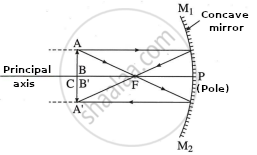
C: Centre of curvature, F: Focus, PF: Focal length (f), PC: Radius of curvature (R), AB: Object, A'B': Image, PB: Object distance (u), PB': Image distance (ν)
In this situation the image is formed at the center of curvature only. It is real, inverted and similar in size. - Object between infinity and Centre of curvature:

C: Centre of curvature, F: Focus, PF: Focal length (f), PC: Radius of curvature (R), AB: Object, A'B': Image, PB: Object distance (u), PB': Image distance (ν)
Here the image is between the center of curvature and the principal focus. The image is real, inverted and smaller than the object. - Object at infinity:

C: Centre of curvature, F: Focus, PF: Focal length (f), PC: Radius of curvature(R), AB: Object at infinity
In this situation, the image is formed at the principal focus of the concave mirror. It is real, contrasting and much smaller in size.
APPEARS IN
RELATED QUESTIONS
Assertion: For observing the traffic at a hairpin bend in mountain paths a plane mirror is preferred over convex mirror and concave mirror.
Reason: A convex mirror has a much larger field of view than a plane mirror or a concave mirror.
If an object is placed at the focus of a concave mirror, where is the image formed?
- Complete the diagram to show how a concave mirror forms the image of the object.
- What is the nature of the image?
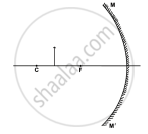
Which of the following ray diagrams is correct for the ray of light incident on a concave mirror as shown in Figure?

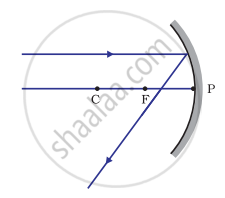 |
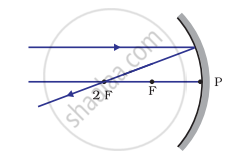 |
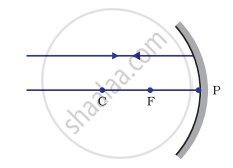 |
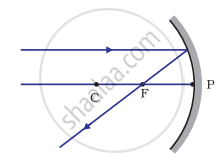 |
| Fig. A | Fig. B | Fig. C | Fig. D |
Draw ray diagrams showing the image formation by a concave mirror when an object is placed
- between pole and focus of the mirror
- between focus and centre of curvature of the mirror
- at centre of curvature of the mirror
- a little beyond centre of curvature of the mirror
- at infinity
List four properties of the image formed by the concave mirror when the object is placed between F & P.
Rohit wants to have an erect image of an object using a converging mirror of focal length 40 cm.
- Specify the range of distance where the object can be placed in front of the mirror. Justify.
- Draw a ray diagram to show image formation in this case.
- State one use of the mirror based on the above kind of image formation.
A 10 cm long pencil is placed 5 cm in front of a concave mirror having a radius of curvature of 40 cm.
- Determine the position of the image formed by this mirror.
- What is the size of the image?
- Draw a ray diagram to show the formation of the image as mentioned in part (i).
